The POW Dispatch: Our take on climate news, March 5, 2021

WORDS & HEADER IMAGE: DONNY O’NEILL
Welcome to The Dispatch, Protect Our Winters’ weekly wrap-up of climate news, complete with our take on each topic and how that impacts our ongoing efforts to reduce the effects of climate change.
Before we dive into this week’s Dispatch, we encourage you to get outside and CrushIt4Climate this March. Not sure what that is? Never fear, we have all the details (and a few rad prizes to giveaway), here.
Representative Deb Haaland is on the cusp of being confirmed as the new Secretary of the Department of the Interior (DOI). This will be a groundbreaking confirmation and we’ll tell you why it’s so important for protecting our outdoor spaces from the effects of climate change. Additionally, the CORE Act passed through the House for the third time (third time’s a charm, right?), Special Climate Envoy John Kerry turns to Wall Street to address climate change and the National Park Service is leading the electric vehicle revolution within the federal government. Read up on all of this week’s climate news via this week’s POW Dispatch.

Notable Quote:
“We need to care as much about the environment as we do about the fossil fuel infrastructure in your states and other states, we need to balance those priorities. If we have a mind to protect our public lands for future generations that we’ll also be able to protect jobs for future generations as well.” – Rep. Deb Haaland (D-N.M.)
Our Takeaway:
Representative Deb Haaland’s confirmation as Secretary of the DOI is one step closer after the Senate Energy and Natural Resources Committee (ENR) voted to advance her nomination on Thursday. The ENR voted 11 to 9 to confirm her, with Senator Lisa Murkowski (R-Alaska) voting across party lines in favor of Haaland. Senator Susan Collins (R-Maine) has also pledged to support the nomination, likely giving her the votes to be confirmed.
This is colossal news. Haaland will be the first Native American cabinet secretary in the country’s history and will assume a role that has a significant impact on America’s indigenous population. Additionally, Haaland has taken stances opposing fossil fuel development on public lands, supporting a clean energy infrastructure and promoting the outdoor recreation economy. Haaland’s ascension to the top of the department overseeing America’s public lands foreshadows a ton of progress in ridding public lands of carbon emissions and safeguarding them for present and future outdoor enthusiasts.
You can help move Representative Haaland’s nomination along. It’s simple; call your Senator and ask them to support Haaland’s nomination—just call (202) 224-3121 and the operator will connect you directly with the Senate office you request.

Article Synopsis:
Hiring someone with Gallogly’s experience is an indication Kerry plans to leverage markets and investing strategies to address climate change. Gallogly is the highest-profile New York investor to sign on to the Biden administration.
Our Takeaway:
Both technological and financial solutions are integral to our ability to address climate change. In this case, “Mo Money Mo Action.” Special Climate Envoy John Kerry knows the United States needs to raise a hefty cash purse to address climate change.
According to Axios, Mark Gallogly, a Wall Street veteran and former member of the Economic Recovery Advisory Board under the Obama administration, will join John Kerry’s international climate team. This foreshadows Kerry’s intentions to rely on financial markets and investing strategies to help address climate change. Gallogly’s job will be to focus on reaching out to the business community in order to raise the finances needed to create the systemic changes needed to build a clean energy economy.
Financial solutions are key to incentivizing a clean energy future complete with big-scale renewables, energy storage, tax credits and carbon pricing. The “green” in the green energy economy isn’t just in reference to renewables; it’ll take a mountain of greenbacks to accomplish this goal as well.
Since the adoption of the Paris Climate Agreement in 2015, banks have funneled $2.7 trillion into the fossil fuel industry. What’s the simplest way to cut off the flow of carbon emissions into the atmosphere? Cutting off the funds that prop up the fossil fuel industry. And, it’s not just the Wall Street big wigs pouring money into fossil fuels, it’s your own bank! (Check out our work, here, to identify if your bank is supporting fossil fuels.)
As the United States looks to rebuild the economy following the COVID-19 pandemic, it can do so by prioritizing clean power to lessen the impacts of climate change, not only to help protect outdoor recreation opportunities but to create and sustain jobs in the clean energy sector, which accounted for more than 40 percent of America’s entire energy workforce and over 2.25 percent of the nation’s overall employment prior to the pandemic. Working with Wall Street to make climate a top priority is one of the first steps to achieve these economic goals.
The Road to COP26: What you need to know before the next UN climate talks
Climate & Capital Media

The road to COP26 starts today.
Photo: Donny O’Neill
Notable Quote:
“The United States is ready to lead the world on a path to holding warming below 1.5 degrees Celsius.” – Senator Sheldon Whitehouse
Our Takeaway:
Each year, the United Nations Conference of the Parties (COP) serves as the most important climate event on the calendar. COP21, for example, was in Paris and marked the signing of the Paris Climate Agreement. The global summit is an opportunity to gauge global progress towards meeting the goals of the Paris Climate Agreement as well as set new Nationally Determined Contributions (NDCs)—remember these? Learn more via our Paris For Dummies series—to help keep global temperature rise to 1.5 degrees Celsius. COP26 will take place in Glasgow, Scotland, this November, and Climate & Capital Media has put together a few critical issues that need to be addressed during the summit. COP26 may be in November, but the global climate summit will be here before we know it; stay tuned for more updates surrounding POW’s involvement in the coming months.
Establish the “stick.”
COP26 should define necessary actions—the “stick”—to spur climate action from the countries lagging behind on setting policies to meet the targets of Paris. It won’t be simple; like convincing that one friend who always shows up at the trailhead 15 minutes late to try a slightly earlier departure time. The approach needs to move the timeline for climate action forward, account for assisting vulnerable nations with goal setting and preventative measures and finalize a game plan for establishing a resilient global economy. As we noted in our Paris For Dummies series, achieving the goals of the Paris Agreement requires a global effort.
Increase emissions reduction targets
The initial NDCs of the Paris Agreement were always meant to be a first step toward reducing carbon emissions across the globe. Think of it as a big hiking objective; the trail starts out flat, but eventually, you’ll hit that steep ridgeline approach to the summit. More and more evidence now points to the necessity of more ambitious reduction targets in order to keep global temperature rise below 2 degrees Celsius. COP26 is the perfect opportunity to set bigger reduction goals, move forward carbon-neutrality dates and establish consistent reporting methods.
Ramp up financing for climate innovation and solutions
Ring a bell? Financial and technological solutions are a large piece of the puzzle when it comes to achieving the goals of the Paris Agreement. Delegates at COP26 will be tasked with finding innovative ways to incentivize clean energy economies across the globe.
Put Scope 3 emissions back on exporters.
This one is a bit wonky, but Scope 3 emissions are categorized as indirect emissions from a company and its supply chains. The majority of most companies’ carbon footprint comes from outside the organization. This includes emissions from purchased goods and services, business travel, employee commuting, waste disposal and investments. Think of it this way: If your favorite outerwear brand is sourcing textiles from another company with a huge carbon footprint, then its Scope 3 emissions need to be addressed.
COP26 needs to put responsibility for these Scope 3 emissions on the countries producing them, in addition to the companies and countries responsible for their purchase.
Take strong steps to end fossil fuel subsidies.
Cutting off the stream of funds into the fossil fuel industry is the clear way to end the world’s reliance on dirty energy. Funneling those funds into the renewable energy sector doesn’t only set itself up for success, but it helps create tons of green jobs that can fill the holes left by a dwindling fossil fuel industry.
Notable Quote:
“This is one of the largest public lands protection bills to ever go before Congress. Wilderness designation is the strongest protection there is to ensure the lands will never be developed. And it can’t be undone with the stroke of a pen.” – Kristen Brengel, senior vice-president of government affairs for the National Parks Conservation Association
Our Takeaway:
At this point, you’ve probably heard POW talk about the CORE Act so much that you can recite its details off the top of your head. Well, we’re going to touch on it again, because it’s that important and it just passed through the House of Representatives as part of the Protecting America’s Wilderness and Public Lands Act (PAW+).
The CORE Act will protect 400,000 acres of public land while establishing new wilderness areas and designating Camp Hale as a first-ever National Historic Landscape. Additionally, 200,000 acres of federal land will be taken off the table for future oil and gas development. Passing the CORE Act into law isn’t just a big deal for wilderness lovers in Colorado; if passed, the CORE Act, along with the other pieces of legislation in PAW+, set a precedent for future public lands legislation that safeguards natural playgrounds for recreational purposes and blocks oil and gas development. It’s like a rope drop on a powder day; once a single person drops into that untouched goodness, many more are sure to follow.
Not to ruin the fun, but let’s not forget that we’ve been here before. The CORE Act, specifically, has passed through the House twice before, only to run out of speed like a snowboarder in the flats once it reached the Senate. Colorado Senators John Hickenlooper and Michael Bennet sent a letter on Wednesday, March 3, to the Senate Committee on Energy and Natural Resources (ENR) Chairman Joe Manchin (D-W.Va) and Ranking Member John Barrasso (R-Wyo.) formally requesting the committee hold a hearing on the CORE Act, specifically.
While the CORE Act sits in the spotlight for the moment, all pieces of legislation under PAW+ can serve as large stepping stones in protecting public lands for the American people. After all, nearly a quarter of the country’s carbon emissions come from public lands and preserving these spaces rather than drilling them hollow can put a huge dent in America’s emissions problem and protect these cherished landscapes.

Notable Quote:
“The federal government owns an enormous fleet of vehicles, which we’re going to replace with clean electric vehicles made right here in America, by American workers.” – President Joe Biden
Our Takeaway:
President Joe Biden has pledged to help get the United States to net-zero emissions by 2050. One of the strategies to do so is removing emissions from the nation’s roads and highways by promoting the widespread development, purchase and use of electric vehicles. In January, President Biden directed federal agencies to “procure carbon pollution-free electricity and clean, zero-emission vehicles,” as part of an executive order. Now, the National Park Service is leading the charge (pun intended) of Biden’s plan to electrify over 645,000 government vehicles.
Zion National Park, which received a $33 million grant from the U.S. Department of Transportation, will be among the first parks to get to work on electrifying its vehicle fleet. Zion’s aging 21-year-old fleet of shuttle buses will be replaced with 26 electric shuttles powered by 27 charging stations.
One of our dreams here at POW is a future where outdoors people can access their favorite natural playgrounds with the assistance of carbon-neutral vehicles. The new bus fleet at Zion will be carbon-efficient, reducing an estimated 192 metric tons of CO2 annually and quieting highway noise that disrupts the experience for visitors and inhabitants of the park.
These improvements at Zion—the third most-visited park in the country in 2020—will extend to national parks nationwide, helping to reduce the carbon footprint coming from public lands. There’s still a ton of type 2 fun ahead when it comes to electrifying the nation—like ensuring the 500,000 charging stations President Biden hopes to install are all powered by renewables—however, electrifying the government’s own automobile fleet is a step in the right direction. Meanwhile, Secretary of Transportation, Pete Buttigieg, is pushing for policies that lower emissions from the transportation sector and the department is offering grants and incentives for low- and zero-emission vehicles in public transit.
“To meet the climate crisis, we must put millions of new electric vehicles on America’s roads,” said Buttigieg. “It’s time to build public charging infrastructure powered by clean energy and make it available in all parts of this country.”
Local Climate News
While national climate topics often dominate the news cycle, there’s still plenty going on surrounding renewables, electrified transit, public lands and more in states and local communities across the nation. Take a look at what’s going on locally via the news blurbs below.
Colorado
Xcel Energy floats “Power Pathway” plan to bring wind, solar power to cities from rural Colorado
New England
New England power fight foreshadows divisive clean energy future
New York
The Empire State Building and its related buildings are now powered by wind
Utah
Hundreds of snowmen make a case in Utah for climate change
Wyoming

